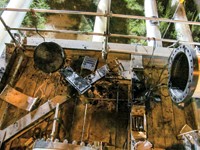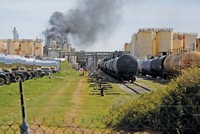Advertisement
Grab your lab coat. Let's get started
Welcome!
Welcome!
Create an account below to get 6 C&EN articles per month, receive newsletters and more - all free.
It seems this is your first time logging in online. Please enter the following information to continue.
As an ACS member you automatically get access to this site. All we need is few more details to create your reading experience.
Not you? Sign in with a different account.
Not you? Sign in with a different account.
ERROR 1
ERROR 1
ERROR 2
ERROR 2
ERROR 2
ERROR 2
ERROR 2
Password and Confirm password must match.
If you have an ACS member number, please enter it here so we can link this account to your membership. (optional)
ERROR 2
ACS values your privacy. By submitting your information, you are gaining access to C&EN and subscribing to our weekly newsletter. We use the information you provide to make your reading experience better, and we will never sell your data to third party members.
Safety
Report Warns of Tank Hazards
Chemical Safety Board: Report urges greater security at tank storage sites
by Jeff Johnson
October 28, 2011

Since 1983, 44 members of the public have been killed in fires and explosions at oil and natural gas storage tanks that dot the countryside in much of the U.S, says a report released Oct. 27 by the Chemical Safety & Hazard Investigation Board (CSB). The report identifies some 26 incidents and calls for new measures to protect the public from accidents at these sites.
“Oil and gas storage sites are part of the landscape in many rural American communities; hundreds of thousands of similar sites are located across the country,” says CSB Lead Investigator Vidisha Parasram.
“It was a concern to discover that issues related to public safety are rarely considered prior to placement and design of these sites,” Parasram points out. “In many cases sites can be as close as 150 to 300 feet from existing buildings, residences, schools, and churches, and still lack warnings or barriers to prevent public access.”
The report finds more than 800,000 remote exploration and production tank sites exist in the U.S., storing natural gas and crude oil. Many sites lack full fencing, warning signs, locked gates, locks on tank hatches, and other physical barriers. CSB also finds that children and young adults frequently socialize and play at the tank storage sites, unaware of their potentially hazardous contents.
The report examines in detail three fatal incidents that occurred in Mississippi, Oklahoma, and Texas between October 2009 and April 2010. It recommends that the Environmental Protection Agency issue a safety bulletin, warning of the hazards of these tanks and making clear the importance of limiting access.
It also urges the American Petroleum Institute and the National Fire Protection Association to improve their existing codes and guidance documents to reflect this hazard.
In addition, CSB recommends that state regulators and EPA consider requiring storage facility owners to use inherently safer tank design features—such as flame arrestors, pressure vacuum vents, floating roofs, and vapor recovery systems—to reduce the possibility of an accident at these seemingly remote sites.
For Mississippi, Oklahoma, and Texas, the board recommends that they address gaps in existing codes and guidances that led to the accidents the board investigated. California, a major oil producing state, the report notes, requires security measures at storage sites and has had no accidents from 1983 to present, the period the board examined.
The board has also prepared a video—“No Place to Hang Out”—on the dangers of oil well storage sites.




Join the conversation
Contact the reporter
Submit a Letter to the Editor for publication
Engage with us on Twitter